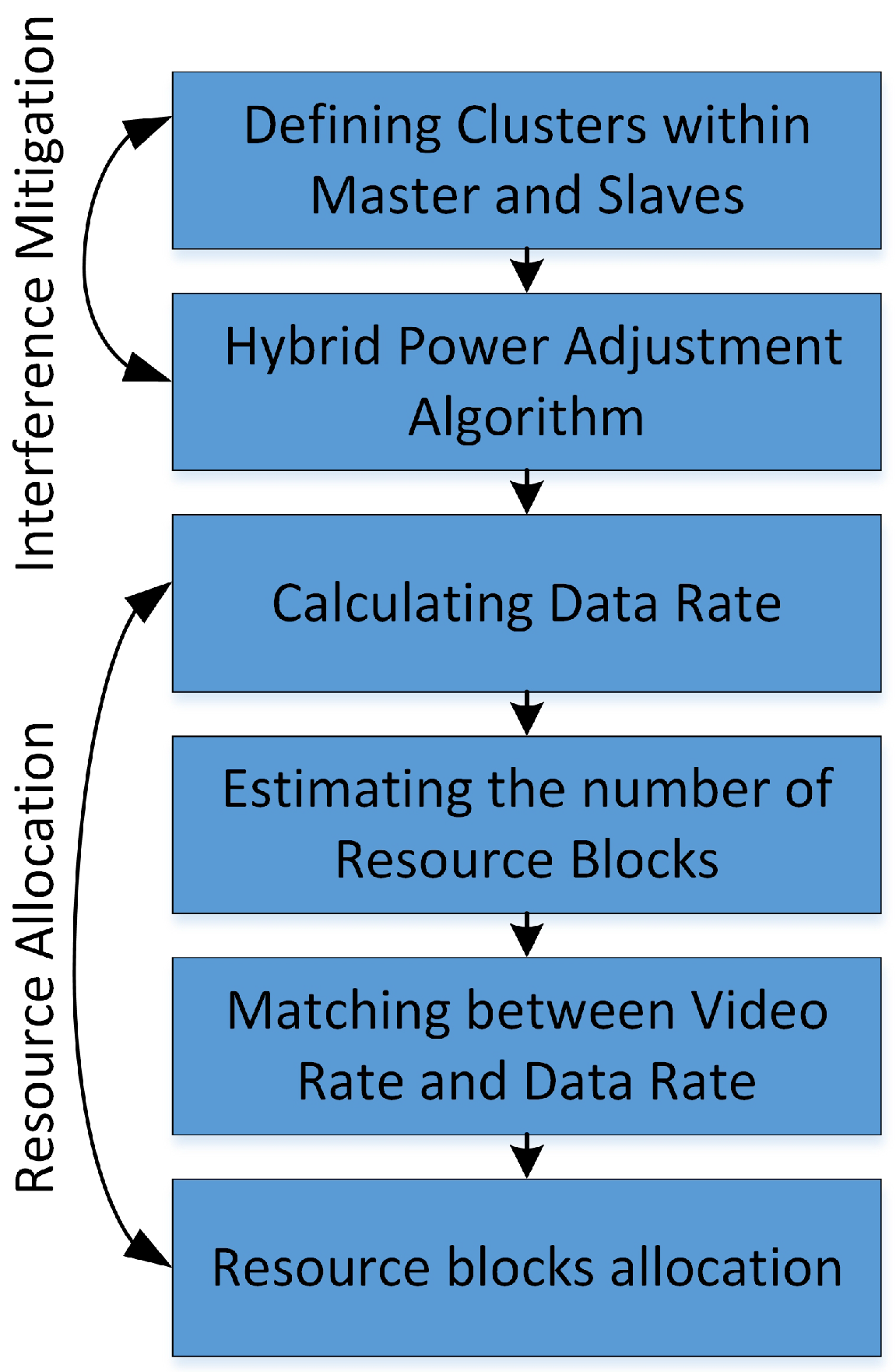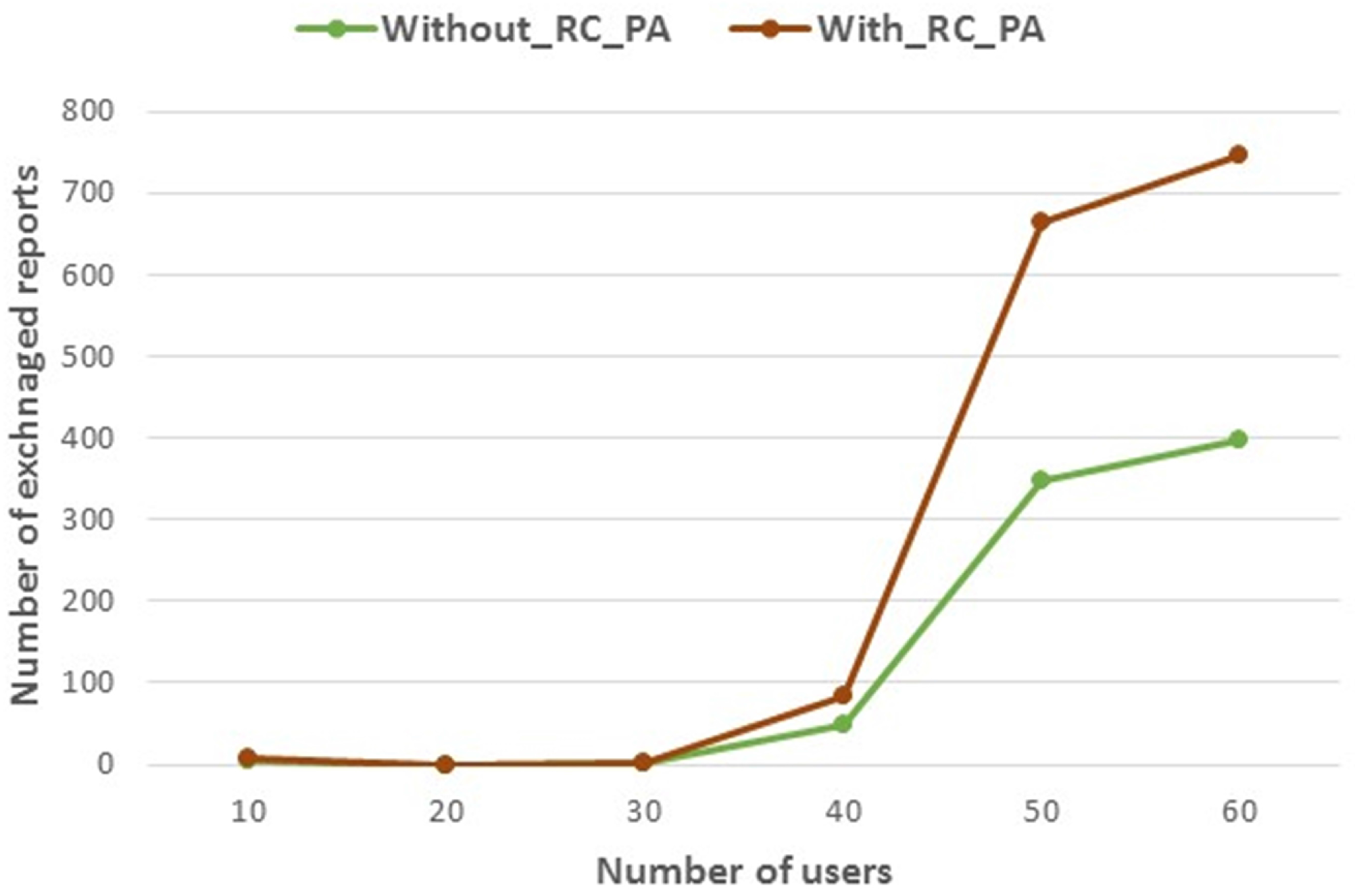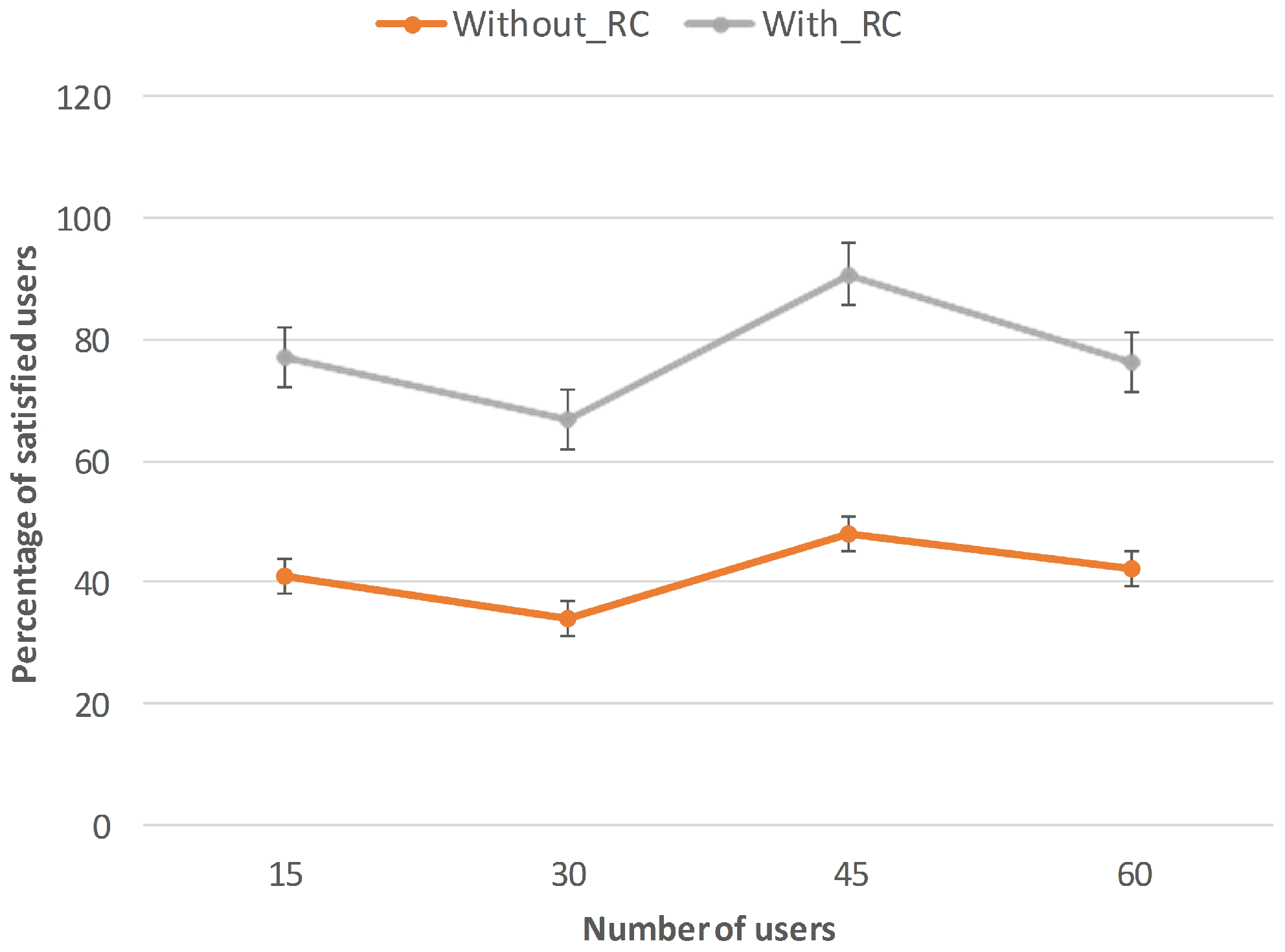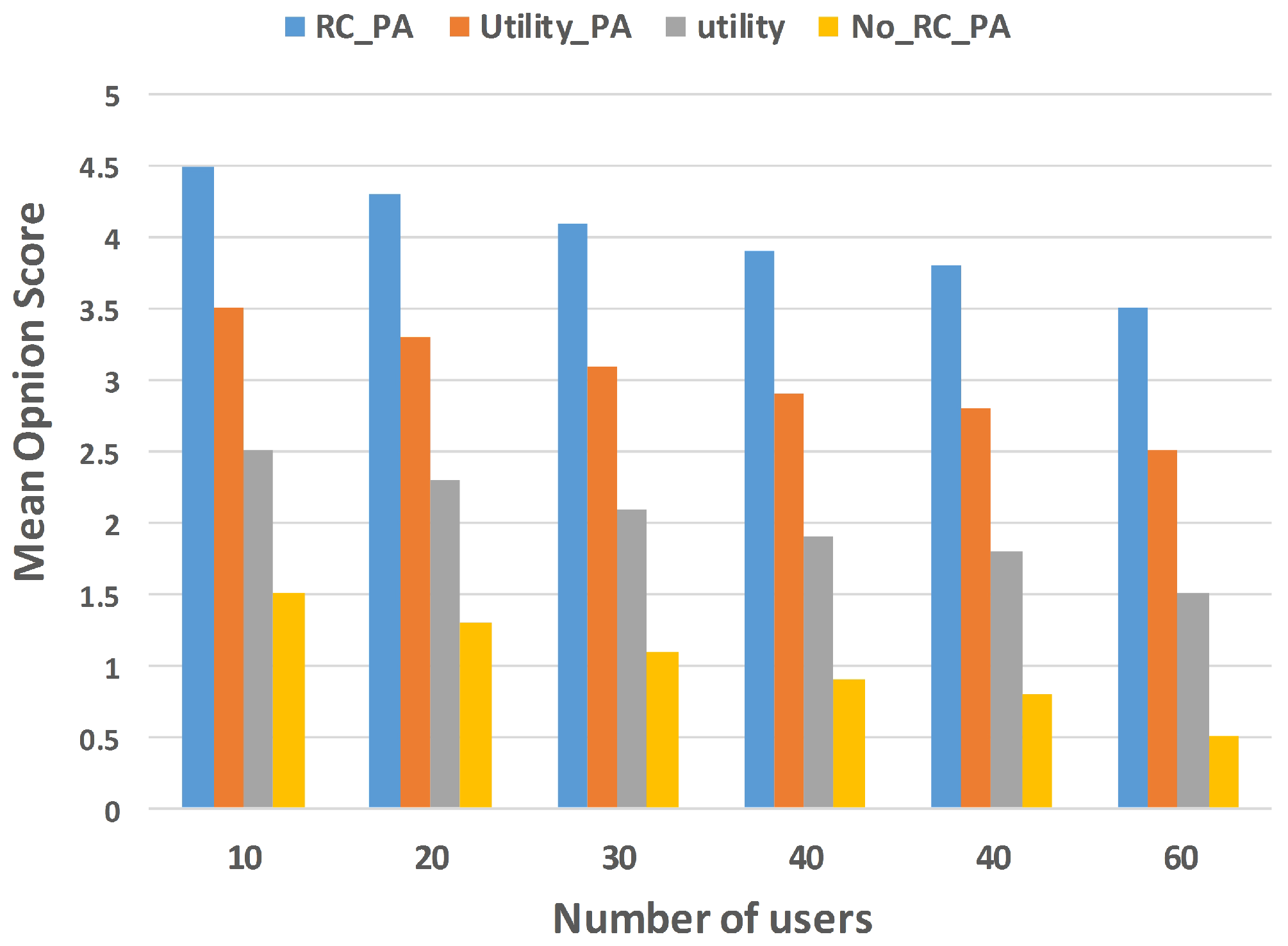Performance Study of Adaptive Video Streaming in an Interference Scenario of Femto-Macro Cell Networks
Abstract
:1. Introduction
2. Related Work
3. System Model and Assumptions
4. A Hybrid Algorithm for Power Allocation in Macrocell/Femtocell Architecture
- Consider the case when a () captures the report generated by a where the is fulfilling the Equations (4) and (5), respectively. In addition, when a is close to the neighboring , it is considered that the channel gain is known from a ; however, there is a lack of shadowing and fast fading components, thus the can be represented as follows:where . Subsequently, the distance between and an is known too, hence an can detect if the attenuation wall is counted within the aforementioned or not.
- It is expected that an finds the or it can capture it directly from an . Then, an minimizes the transmitted power in a certain context in order to ensure the required QoS of a victim . To do so, the must be greater than the as in Equation (9):
- Then, can adjust the allocation from to according to Equation (9) based on and and substituting them in Equation (9):Equating the RSSs on each side implies that
| Algorithm 1 Hybrid Power Allocation |
| Initiate |
| if then |
| calculate |
| end if |
| for all do |
| if then |
| calculate |
| end if |
| if then |
| M identifies the received on as the interfering signal |
| end if |
| end for |
| for all do |
| find the average number of the MUEs impacted by femtocell |
| where |
| end for |
| for all do |
| sort in a descending order |
| create Master and Slave clusters according to |
| calculate the maximum interference allowed by the victims |
| for all Master-Fs do |
| calculate power adjustment |
| end for |
| for all Slave-Fs do |
| calculate power adjustment |
| end for |
| end for |
5. Adaptive Resource Allocation for Video Streaming
5.1. Estimating Link Data Rate
- The achievable data rate for all video connections in the system is calculated according to their CQIs.
- The number of RBs for video connection in the system is calculated depending principally on the video and the physical layer data rates. Thus, the calculation of the number of RBs can be achieved by the following equation:where is the average traffic rate for video connection i . In essence, this allocation exploits multiuser diversity by allocating more RBs to the connection with better channels. For instance, assuming that average traffic rates of all connection are equal , the factor is equal to one. A connection with relatively good channel conditions, i.e, its will initially be allocated two or more RBs. On the other hand, a UE with relatively bad channel conditions will initially be allocated only one RB. The role of weighting factor is to weight the allocation proportional to video’s average rate [26].
5.2. Matching between Resource Blocks and SVC Segments
6. Simulation Analysis
6.1. Network Topology
6.2. Performance Evaluation
7. Conclusions
Author Contributions
Conflicts of Interest
References
- Chandrasekhar, V.; Andrews, J.G.; Gatherer, A. Femtocell Networks: A Survey. IEEE Commun. Mag. 2008, 46, 59–67. [Google Scholar] [CrossRef]
- López-Pérez, D.; Valcarce, A.; Ladányi, A.; de la Roche, G.; Zhang, J. OFDMA Femtocells: A Roadmap on Interference Avoidance. IEEE Commun. Mag. 2009, 47, 41–48. [Google Scholar] [CrossRef]
- Yahiya, T.A. Understanding LTE and Its Performance, 1st ed.; Springer: New York, NY, USA, 2011; pp. 1–244. ISBN 978-1-4419-6457-1. [Google Scholar]
- Cisco. Cisco Visual Networking Index Predicts Global Annual IP Traffic to Exceed Three Zettabytes by 2021. Available online: Investor.cisco.com (accessed on 6 August 2017).
- Kumar, S.; Sarkar, A.; Sur, A. A Resource Allocation Framework for Adaptive Video Streaming over LTE. J. Netw. Comput. Appl. 2017, 97, 126–139. [Google Scholar] [CrossRef]
- Wu, J.; Yuen, C.; Cheng, B.; Wang, M.; Chen, J. Energy-Minimized Multipath Video Transport to Mobile Devices in Heterogeneous Wireless Networks. IEEE J. Sel. Areas Commun. 2016, 34, 1160–1178. [Google Scholar] [CrossRef]
- Abbas, N.; Hajj, H.; Dawy, Z.; Jahed, K.; Sharafeddine, S. An optimized approach to video traffic splitting in heterogeneous wireless networks with energy and QoE considerations. J. Netw. Comput. Appl. 2017, 83, 30–49. [Google Scholar] [CrossRef]
- Wu, J.; Cheng, B.; Wang, M.; Chen, J. Energy-Efficient Bandwidth Aggregation for Delay-Constrained Video Over Heterogeneous Wireless Networks. IEEE J. Sel. Areas Commun. 2017, 35, 30–49. [Google Scholar] [CrossRef]
- Wu, J.; Cheng, B.; Yuen, C.; Shang, Y.; Chen, J. Distortion-Aware Concurrent Multipath Transfer for Mobile Video Streaming in Heterogeneous Wireless Networks. IEEE Trans. Mob. Comput. 2015, 14, 688–701. [Google Scholar] [CrossRef]
- Petrangeli, S.; Wu, T.; Wauters, T.; Huysegems, R.; Bostoen, T.; Turck, F.D. A Machine Learning-Based Framework for Preventing Video Freezes in HTTP Adaptive Streaming. J. Netw. Comput. Appl. 2017, 94, 78–92. [Google Scholar] [CrossRef]
- Hwang, J.; Lee, J.; Yoo, C. Eliminating Bandwidth Estimation from Adaptive Video Streaming in Wireless Networks. Signal Process. Image Commun. 2016, 47, 242–251. [Google Scholar] [CrossRef]
- Zhao, M.; Gong, X.; Liang, J.; Wang, W.; Que, X.; Cheng, S. Qoe-Driven Cross-Layer Optimization for Wireless Dynamic Adaptive Streaming of Scalable Videos over Http. IEEE Trans. Circuits Syst. Video Technol. 2015, 25, 451–465. [Google Scholar] [CrossRef]
- Taha, M.; Lloret, J.; Canovas, A.; Garcia, L. Survey of Transportation of Adaptive Multimedia Streaming service in Internet. Netw. Protoc. Algorithms 2017, 9, 85–125. [Google Scholar] [CrossRef]
- Taha, M.; Garcia, L.; Jimenez, J.M.; Lloret, J. SDN-based throughput allocation in wireless networks for heterogeneous adaptive video streaming applications. In Proceedings of the 13th International Wireless Communications and Mobile Computing Conference (IWCMC 2017), Valencia, Spain, 26–30 June 2017. [Google Scholar]
- Liu, Y.; Liu, J.; Song, J.; Argyriou, A. Scalable 3D Video Streaming over P2P Networks with Playback Length Changeable Chunk Segmentation. J. Vis. Commun. Image Represent. 2015, 31, 41–53. [Google Scholar] [CrossRef]
- Kimball, J.; Wypych, T.; Kuester, F. Low Bandwidth Desktop and Video Streaming for Collaborative Tiled Display Environments. Future Gener. Comput. Syst. 2016, 54, 336–343. [Google Scholar] [CrossRef]
- Ho, D.; Park, Y.; Song, H. QoS-Supporting Video Streaming System with Minimum Data Service Cost over Heterogeneous Wireless Networks. J. Vis. Commun. Image Represent. 2013, 24, 1293–1302. [Google Scholar] [CrossRef]
- Moon, S.; Yoo, J.; Kim, S. Adaptive Interface Selection over Cloud-Based Split-Layer Video Streaming via Multi-Wireless Networks. Future Gener. Comput. Syst. 2016, 56, 664–674. [Google Scholar] [CrossRef]
- Tassi, A.; Chatzigeorgiou, I.; Vukobratovi’c, D. Resource-Allocation Frameworks for Network-Coded Layered Multimedia Multicast Services. IEEE J. Sel. Areas Commun. 2015, 33, 141–155. [Google Scholar] [CrossRef] [Green Version]
- Cordeschi, N.; Amendola, D.; Shojafar, M.; Baccarelli, E. Distributed and Adaptive Resource Management in Cloud-Assisted Cognitive Radio Vehicular Networks with Hard Reliability Guarantees. Veh. Commun. 2015, 2, 1–12. [Google Scholar] [CrossRef]
- Zhou, H.; Ji, Y.; Wang, X.; Zhao, B. Joint Resource Allocation and User Association for SVC Multicast Over Heterogeneous Cellular Networks. IEEE Trans. Wirel. Commun. 2015, 14, 3673–3684. [Google Scholar] [CrossRef]
- Choi, Y.I.; Kang, C.G. Scalable Video Coding-Based MIMO Broadcasting System with Optimal Power Control. IEEE Trans. Broadcast. 2017, 63, 350–360. [Google Scholar] [CrossRef]
- Yahiya, T.A. Adaptive Video Streaming Rate Control for HetNet Based on Interference Scenarios. In Proceedings of the IFIP Wireless and Mobile Networking Conference, Valencia, Spain, 25–27 September 2017. [Google Scholar]
- Kurda, R.; Yahiya, T.A.; Yiltas-Kaplan, D.; Kirci, P. A Cluster Based Scheme for Interference Mitigation in Mobile Macrocell-Femtocell Networks. In Proceedings of the 14th International Conference on ITS Telecommunications, Copenhagen, Denmark, 2–4 December 2015; pp. 60–64. [Google Scholar]
- Yang, J.; Ran, Y.; Chen, S.; Li, W.; Hanzo, L. Online Source Rate Control for Adaptive Video Streaming over HSPA and LTE-Style Variable Bit Rate Downlink Channels. IEEE Trans. Veh. Technol. 2016, 65, 643–657. [Google Scholar] [CrossRef]
- Yahiya, T.A.; Beylot, A.L.; Pujolle, G. An Adaptive Cross-Layer Design for Multiservice Scheduling in OFDMA Based Mobile WiMAX Systems. Comput. Commun. 2009, 32, 531–539. [Google Scholar] [CrossRef]
- Piro, G.; Grieco, L.A.; Boggia, G.; Capozzi, F.; Camarda, P. Simulating LTE Cellular Systems: An Open-Source Framework. IEEE Trans. Veh. Technol. 2011, 60, 498–513. [Google Scholar] [CrossRef]
- Kurda, R.; Boukhatem, L.; Yahiya, T.A. Interference Mitigation in Mobile Environment Through Power Adjustment in Macro and Femto Cell Systems. In Proceedings of the IEEE Wireless Communications and Networking Conference (WCNC), Istanbul, Turkey, 6–9 April 2014; pp. 1733–1738. [Google Scholar]
- Wang, X.; Chen, M.; Kwon, T.T.; Yang, L.; Leung, V.C.M. AMES-Cloud: A Framework of Adaptive Mobile Video Streaming and Efficient Social Video Sharing in the Clouds. IEEE Trans. Multimedia 2013, 15, 811–820. [Google Scholar] [CrossRef]
- Khan, S.; Duhovnikov, S.; Steinbach, E.; Sgroi, M.; Kellerer, W. Application-Driven Cross-Layer Optimization for Mobile Multimedia Communication Using a Common Application Layer Quality Metric. In Proceedings of the International Wireless Communications and Mobile Computing Conference (IWCMC ’06), Vancouver, BC, Canada, 3–6 July 2006; pp. 213–218. [Google Scholar]
- Nemethova, O.; Ries, M.; Zavodsky, M.; Rupp, M. PSNR Based Estimation of Subjective Time-Variant Video Quality for Mobiles. In Proceedings of the International Conference on Measurement of Audio and Video Quality in Networks (MESAQIN ’06), Prague, Czech Republic, 5–6 June 2006. [Google Scholar]







| Acronym | Meaning |
|---|---|
| BL | Base Layer |
| CMT-DA | Distortion-Aware Concurrent Multipath Transfer |
| CQI | Channel Quality Indicator |
| CSG | Close Subscriber Group |
| DASH | Dynamic Adaptive Streaming over HTTP |
| DL | Downlink |
| EL | Enhancement Layer |
| ELBA | Energy-QuaLity Aware Bandwidth Aggregation |
| EVIS | Energy-Video Aware Multipath Transport Protocol |
| FBS | Femtocell Base Station |
| FDD | Frequency Division Duplex |
| FUE | Femtocell User Equipment |
| HAS | HTTP Adaptive Streaming |
| HetNet | Heterogeneous Networks |
| HTTP | Hypertext Transfer Protocol |
| ILP | Integer Linear Programming |
| LTE | Long-Term Evolution |
| LTE-A | Long-Term Evolution Advanced |
| MBS | Macrocell Base Station |
| MCS | Modulation and Coding Scheme |
| MIMO | Multi-Input Multioutput |
| ML | Machine Learning |
| MOS | Mean Opnion Score |
| MUE | Macrocell User Equipment |
| OFDMA | Orthogonal Frequency Division Multiple Access |
| PA | Power Allocation |
| PLC3DCS | Playback Length Changeable 3D Video Data Chunk Segmentation |
| PLR | Packet Loss Ratio |
| PSNR | Peak Signal-to-Noise Ratio |
| QoE | Quality of Experience |
| QoS | Quality of Service |
| RAN | Radio Access Network |
| RB | Resource Block |
| RSS | Received Signal Strength |
| SDN | Software Defined Network |
| SDQA | Streamlined DP-based Quality-level Allocator |
| SINR | Signal to Interference Noise Ratio |
| SVC | Scalable Video Coding |
| TCP | Transmission Control Protocol |
| TDD | Time Division Duplex |
| UL | Uplink |
| WLAN | Wireless Local Area Network |
| WQUAD | Wireless Quality Adaptation |
| Symbol | Meaning |
|---|---|
| M | A macrocell |
| A femtocell l | |
| L | Set of femtocells |
| I | Set of MUEs |
| J | Set of FUEs |
| K | Set of RBs |
| k | A RB k |
| A macrocell user i | |
| A femtocell user j | |
| Power of the additive White Gaussian noise | |
| SINR of a given associated with MBS M on RB k | |
| Channel fast fading gain between M and on RB k | |
| Channel fast fading gain between and the neighboring on RB k | |
| Set of all interfering FBSs on user on RB k | |
| Transmit power allocated on RB k by the serving cell M | |
| Received signal strength by from MBS M on RB k | |
| Received signal strength by from FBS on RB k | |
| Transmit power allocated on RB k by the serving femtocell | |
| New value of transmission power of femtocell on RB k | |
| Clusters | |
| y | Index of the cluster |
| Geographical position of the femtocell | |
| Repeated position | |
| Total number of MUE | |
| Average traffic rate for video connection i | |
| Q | Operational mode set of the video encoder |
| Path loss exponent with the distance between T and R | |
| Shadowing component | |
| Fast fading component | |
| X | Total number of MUEs and FUEs |
| Average traffic rate for video connection | |
| Average data rate for the RB k | |
| X | Total number of MUEs and FUEs |
| Rate of enhancement layer | |
| Rate of base layer |
| Parameters | Values | Parameters | Values |
|---|---|---|---|
| Macrocells | 1 | Thermal noise density | −174 dBm/Hz |
| Femtocells | 30 | Carrier frequency | 3.5 GHz |
| MUEs | 15–60 | UE noise figure | 2.5 dB |
| FUEs | 4 | Macrocell radius | 500 m |
| bandwidth | 10 MHz | FUEs average speed | 3 km/h |
| RB bandwidth | 50 | MUEs average speed | 30 km/h |
| Macro Tx power | 43 dBm | 5.7 dB | |
| Femto Tx power | 23 dBm | Simulation Time | 60 s |
© 2018 by the authors. Licensee MDPI, Basel, Switzerland. This article is an open access article distributed under the terms and conditions of the Creative Commons Attribution (CC BY) license (http://creativecommons.org/licenses/by/4.0/).
Share and Cite
Ali Yahiya, T.; Kirci, P. Performance Study of Adaptive Video Streaming in an Interference Scenario of Femto-Macro Cell Networks. Information 2018, 9, 22. https://doi.org/10.3390/info9010022
Ali Yahiya T, Kirci P. Performance Study of Adaptive Video Streaming in an Interference Scenario of Femto-Macro Cell Networks. Information. 2018; 9(1):22. https://doi.org/10.3390/info9010022
Chicago/Turabian StyleAli Yahiya, Tara, and Pinar Kirci. 2018. "Performance Study of Adaptive Video Streaming in an Interference Scenario of Femto-Macro Cell Networks" Information 9, no. 1: 22. https://doi.org/10.3390/info9010022





